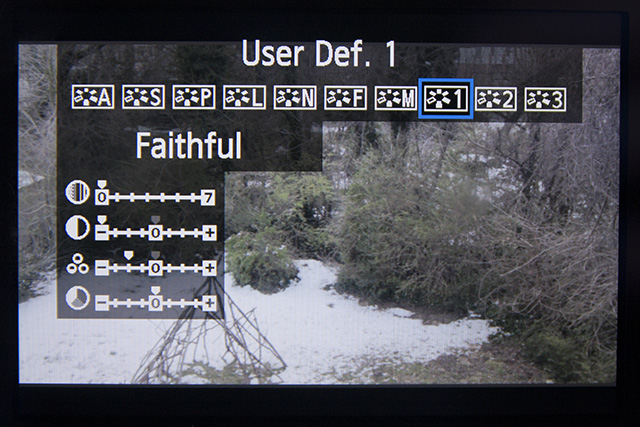Canon Picture Styles Explained
The Canon EOS system of digital single-lens reflex ( SLR) bodies and lenses is a standard choice among professional photographers worldwide. This page makes it easy to compare and search for for Canon digital bodies and EOS lenses. Every component manufactured by Canon is covered, plus a few exceptionally good third-party components. If you are new to photography, you might want to start with our article. This article goes through every section of the Canon EOS system and concludes with some starter system recommendations. For the complete catalog of Canon products and Canon-related articles, forum threads, etc, visit the.
Feb 24, 2017 - Canon Picture Styles are set in your Canon camera and are useful to get the desired photo look out of the box. You get this by tweaking color.

Canon EOS Bodies 8570405 Small sensor bodies are good for telephoto work, such as wildlife photography. A 100mm telephoto lens that would be ideal for portraits on a film or full-frame sensor body gives a 150mm equivalent perspective on a small sensor (“ APS-C”) body. APS-H sensor bodies are good for sports photography and photojournalism delivering fast performance. The full-frame sensor bodies are good for wide angle photography, low-light photography, and ultimate image quality.
Current Small-frame Sensor Bodies • canon_eos7d, (Sept. 2009), 18MP; 19 AF points; ISO range 100-6400 (12800 with boost); 3-inch LCD 920,000 dots; 8fps continuous capture; video 1080p HD; CF cards • canon_eos60d, (Aug. 2010), 18MP; 9 AF points; ISO range 100-6400 (12800 with boost); 3-inch LCD 1,040,000 dots; 5.3fps continuous capture; video 1080p HD; SD/ SDHC cards • canon_rebelt3i, (Feb. 2011), 18MP CMOS sensor; 9 AF points; ISO range 100-6400 (12800 with boost); 3-inch LCD 1,040,000 dot resolution; 3.7fps continuous capture; 1080p HD @ 30fps; SD/ SDHC cards • canon_rebelt3-kit, (Feb.
2011), 12MP CMOS sensor; 9 AF points; ISO range 100-6400; 3-inch LCD 230,000 dot resolution; 3 fps for up to 830 JPEG, 2 fps for up to 5 RAW frames; 720p HD; SD/ SDHC cards • canon_rebelt2i, (Feb. 2010), 18MP; 9 AF points; ISO range 100-6400 (12800 with boost); 3-inch LCD 1,040,000 dots; 3.7fps continuous capture; video 1080p HD; SD/ SDHC cards Current APS-H Sensor Bodies • canon_eos1d_mark4, (Oct. 2009), APS-H sized sensor (not quite full-frame), 16MP; 45 AF points; ISO range 100-12800 (up to 102400 with boost); 3-inch LCD 920,000 dots; 10fps continuous capture; video 1080p HD; CF cards Current Full-frame Sensor Bodies • canon_5d-mkiii, (March 2012), 22MP; 61 AF points; ISO range 100-12800 (up to 25600 with boost); 3.2-inch LCD 1.04 million dots; 6fps continuous capture; video 1080p HD; CF or SD cards • canon_eos5d_mark2, (Sept. 2008), 21MP; 9 AF points; ISO range 100-6400 (up to 25600 with boost); 3-inch LCD 920,000 dots; 3.9fps continuous capture; video 1080p HD; CF cards • canon_eos1ds_mark3, (Aug. 2007), 21MP; 45 AF points; ISO range 100-1600 (3200 with boost); 3-inch LCD 230,000 dots; 5fps continuous capture; Discontinued Bodies • Canon Rebel () • Canon Rebel XT () • Canon Rebel XTi () • Canon EOS 10D () • Canon EOS 20D () • Canon EOS 30D () • Canon EOS 40D () • Canon EOS 5D () Search the for discontinued Canon cameras, lenses, and accessories. Nomenclature F-number: lower is better.
Free Canon Picture Styles

IS is “image stabilization”, a technology lifted from camcorders in which the camera electronically compensates for unsteady hands. IS is especially important at long focal lengths, e.g., 200mm and above, because the lens magnifies camera shake at the same time it is magnifying the subject. An IS lens will allow you to use slower shutter speeds without introducing camera shake. The alternative to an IS lens would be mounting the camera on a tripod or using a high ISO setting, which reduces image quality but allows the use of higher shutter speeds. USM is “ultrasonic motor”. All Canon EOS-system lenses have built-in focus motors.
Canon 7d Picture Style Settings
There is no motor in the body as is the case with Nikon, for example. The cheaper Canon lenses have a motor that must be clutched out with a switch if the photographer wishes to focus manually. When using a USM lens, the photographer can push the shutter release (or a button on the rear of the camera, if a custom function is set) and let the autofocus system do its best, then touch up the focus manually by twisting the lens ring.